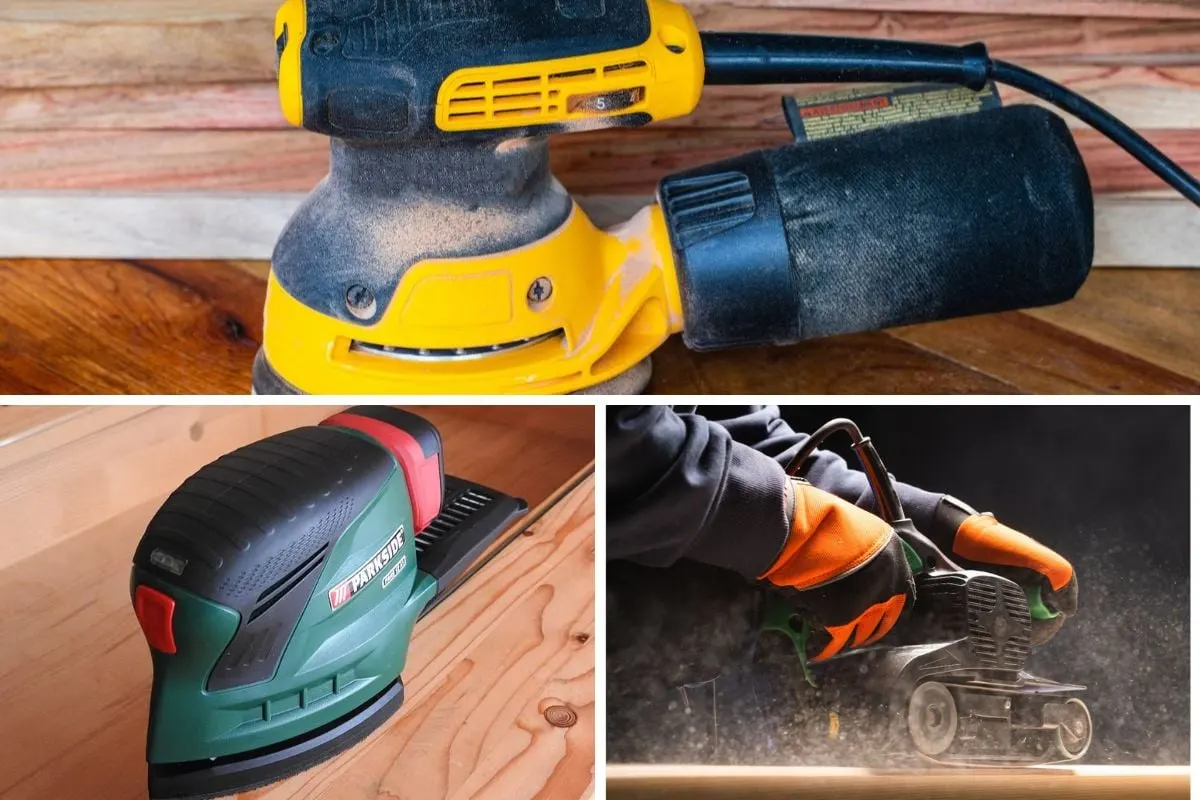Do you want to give your woodworking projects a professional finish? An orbital sander is an effective tool for achieving the perfect finish on your woodwork. You can use it to achieve a smooth, even finish, helping you to create impressive pieces.
In this guide, we’ll explain the benefits of using this type of sander and how you can get the best results.
An orbital sander is an essential tool for any woodworker. This type of sander is equipped with a powerful motor and oscillating pad that allows users to quickly sand and finish wood surfaces. The orbital motion helps reduce fatigue, prevents the creation of deep gouges, and improves overall results. Additionally, the compact design makes this tool very easy to use and maneuverable in tight spaces.
The process of sanding can be tedious and time-consuming without the right tools. With an orbital sander, however, you can make quick work of preparing a surface for painting or staining while still achieving a professional-quality finish. Depending on your needs, orbit sanders come in several styles including circular, random-orbital, belt Sanders and vibrator Sanders. This guide will provide an overview of the types of orbital Sanders available as well as discuss the advantages that they offer over other types of sanders or manual methods such as hand sanding or buffing.
Faster and Efficient Sanding
When you use an orbital sander, your sanding job will be completed quickly and efficiently. The sander’s orbital action means that the sanding surface oscillates in a circular pattern at high speed, reaching into hard-to-reach areas and leaving your wood smooth.
Additionally, orbital sanders are lightweight and easy to maneuver, meaning even intricate designs can be easily sanded without much effort on your part. As a result, it will take you significantly less time to finish your job compared to other types of sanders. Additionally, it produces less dust than using hand-sanding methods or belt sanders, allowing you to work in an environment that is cleaner and healthier for everyone around you.
Explanation of how orbital sanders work
Orbital sanders are a common power tool used in woodworking. They use an electric motor to drive an oscillating or “orbiting” sanding disk, which rotates and vibrates along its plane of motion, providing a uniform and effective sanding action. This type of sander can be used on many types of materials such as wood, veneers, plastics, and ferrous metals.
Designed to reduce the amount of time spent hand-sanding, orbital sanders are powered by one of two sources: either electric or air motors. The motor connects to a drive unit that spins the sandpaper disk at high speed, typically between 3,000 and 10,000 RPM depending on the model. Orbital sanders have adjustable speeds, so they can be tailored to the material being worked with and the user’s preference. The disks come in a variety of sizes ranging from one inch up to six inches in diameter so that they can reach into tight spaces or corners.
These tools are easy to use but require some safety precautions when operating them as these can cause dust particles to become airborne which can be inhaled by anyone nearby if proper safety measures aren’t taken before hand. Always wear protective equipment such as masks and eye wear when working with this type of tool and ensure that all dust is collected safely in either a HEPA filter vacuum cleaner or an enclosed system such as plastic sheeting connected directly to the machine’s exhaust port.
Comparison between orbital sanders and traditional sanding methods
To get the most out of your woodworking projects, there needs to be proper sanding. Sanding by hand is an extremely tedious and tiring process that requires a lot of effort. On the other hand, orbital sanders greatly simplify the process and provide better results in much less time.
Compared to traditional methods such as hand sanding, orbital sanders can offer many advantages. They are typically handheld tools that use a sheet or pad consisting of abrasive surfaces for sanding. In comparison to hand-sanding, using an orbital sander can not only save you time but also produce better results with minimal effort. Orbital sanders offer smoother and more consistent finishes than would be possible with manual stroking or block-sanding techniques.
The key difference between orbital sanders and traditional methods comes down to the motion of the sander itself during operation. Instead of manual back-and-forth motions across wood surfaces, most orbital sanders have circular or orbit-like motions on a horizontal plane that help speed up the finishing process while providing more uniformity. Additionally, their higher power output makes them more effective at removing material quickly when compared to traditional methods.
Explanation of how orbital sanders can speed up the sanding process
When it comes to power sanders, orbital sanders are actually some of the most beneficial tools for woodworking projects. These smaller sanders are easy to handle, they can fit into tight corners and they deliver just the right amount of power to get any job done quickly. While palm or hand sanders may still be used in some applications, orbital sanders are typically preferred when it comes to larger projects or those that require a detailed level of accuracy.
The main benefit of using an orbital sander is that it leaves behind a smoother surface than other types of sanders. This smoother surface eliminates the need for further finishing after the project has been completed and is a huge time saver. Orbital sanders also feature adjustable speeds which allow users to choose the ideal speed in order to guarantee top-notch results each and every time. They also come with a dust collection system that collects dust from both sides of the workpiece, making it much faster and easier for cleanup after completion.
Finally, orbital sanders have multiple functions which make them versatile as well as efficient, handling various tasks such as buffing surfaces, rounding edges and flattening surfaces with ease – making them one of the most useful pieces of equipment in your shop!
Smooth Finishing
An orbital sander is an efficient and cost-effective tool that can be used to achieve a smooth, even finish on wood surfaces. It is the perfect tool for tasks such as sanding wood furniture, floors, door frames, and other projects that require a clean, polished look. The oscillating motion of the sander helps to refine and level out rough edges to create a uniformly smooth surface.
Before you start sanding your project with an orbital sander, it is important to understand how it works and how best to utilize its features.
The sandpaper on the unit has small diameters that move in small circles or “orbits” which give it its name— orbital sander. This orbiting motion helps distribute the material more evenly over larger surfaces for a smoother finish. Additionally, with an adjustable speed range from 4500 to 7000 RPM (revolutions per minute) you can customize your experience based on what type of material you are working with or the kind of finish you are striving for. The optimal speed can generally be found by trial and error; however, it is important not to use too much pressure when sanding as this will result in damages or unevenness on the wood’s surface.
The ability to continually adjust the sandpaper is also one factor which makes orbital sander ideal for larger projects. Sander sheets are easily replaceable allowing you to switch up grits when needed without having to laboriously replace each piece individually by hand. Additionally there are varying weights available so depending on how much control over your design output you would like there should be something suitable available within each budget range – from strong heavy-duty models suitable for fine detailing or mass production work right down through lighter boards good for general home DIY jobs etc.. As always safety should never be compromised so eye protection gear should always be worn when using any power tool such as an orbital sander!
Explanation of how orbital sanders can produce smooth finishes
Orbital sanders are a tool used primarily in woodworking projects, but can also be used to finish metal surfaces. Their compact size and random mechanism allow them to easily maneuver into tight spots and small areas such as shutters, crown molding, and other carefully crafted wood pieces.
Unlike conventional sanders which move in straight lines and cause visible sanding marks on the surface that need to be gone over again, orbital sanders rotate in a random orbit pattern, eliminating linear marks on the material. This ability makes the orbital sander the most efficient choice when it comes to sanding smooth surfaces.
The random orbit movement also creates an incredibly smooth finish with fewer unnecessary strokes than ever before. The weight of the sander is evenly distributed across its entire platform, allowing for even pressure contact as it moves along your project piece. Wobbling movements common with handheld options are completely eliminated with this device, creating cleaner lines without unsightly transitions from one section to the next.
Orbital sanders achieve their results by operating at higher speeds (between 7500-12000 OPM) combined with varying abrasives that increase their efficacy beyond what any other type of sander or grinder can provide.
Comparison between finishes produced by orbital sanders and traditional sanding methods
When deciding whether to choose an orbital sander or a traditional sanding method, it’s important to consider the finish produced. Generally speaking, orbital sanders are able to provide a better finish with less time and effort than traditional methods. Orbital sanders leave behind far fewer visible circular marks than traditional methods of sanding, making them an ideal choice for many woodworking projects. Additionally, as the sander orbits around the workpiece during operation, it ensures that uneven areas and gouges are leveled out–leaving behind a more consistent and aesthetically pleasing surface.
Another advantage is that orbital sanders will produce smoother edges on square-cut pieces of wood faster than conventional tools like hand planes or belt Sanders due to their precise motion in combination with consistent speed control. Plus, because electric-powered orbital sanders vibrate as they operate, friction between the paper and the surface being worked on is minimized–resulting in less dust created throughout the project. As a result of these key aspects, orbital sanders generally produce finer finishes on wood varieties than do manual techniques like hand planing or buffing.
Importance of smooth finishing in woodworking projects
Woodworking projects require a smooth finish in order to achieve the desired aesthetic result. Without it, the project is likely to suffer from an uneven surface or visible bumps and indentations. Using an orbital sander is one of the most efficient ways to get that smooth finish without having to put in a lot of time and effort.
An orbital sander ensures that your workpiece is completely smoothed out. This type of sander oscillates in small circles while spinning, giving you a more even finish than you would get with hand sanding. The round motion helps to blend the sanded surfaces into each other seamlessly without any jagged edges or rough surfaces. It also helps reduce the risk of leaving scratches or gouges on delicate woods, making it ideal for a wide range of projects that require fine finishes, such as furniture restoration, boatbuilding and musical instrument manufacturing.
In addition to its ability to provide a smooth finish, orbital sanders are also known for their speed and versatility when compared with traditional hand sanding techniques. With its powerful motor and adjustable speed settings, an orbital sander can cover large areas quickly and effectively, reducing your woodworking project time significantly. The portability of an orbital sander allows you to work in tight spaces and unusual angles which may not be possible with larger belt or stationary sanders. By utilizing an orbital sander, you are ensuring that your woodworking project will look professional once it completes — free from dust particles or inconsistent finishes!
Versatility and Compatibility
Orbital sanders provide an efficient and versatile option for a variety of woodworking projects. Not only are they capable of tackling a wide range of tasks, but they can also be used with various accessories, such as corner sanders and random orbital pads. This makes them extremely compatible and applicable to a number of woodworking applications.
Depending on the surface being worked on and the desired finish, orbital sanders can be used with different grits to achieve the perfect result with improved safety features such as variable speed controls. This further allows for more accurate results when working with difficult materials or for reconditioning old surfaces. Additionally, their versatility makes them adaptable to a wide range of tasks from rough sanding to fine polishing with generally no loss in power over time.
The diversity in attachments also allows for more accents that give your project an elegant look. With an orbital sander, you can easily add texture or which ultimately creates visual interest and catches the eye, making this tool essential for both hobbyists and pros alike. Whether you are a furniture maker or DIYer, using an orbital sander is one surefire way to create smooth pristine surfaces without the risk of damaging delicate details or risking too much hand fatigue that traditional manual sanding often brings.
Conclusion
The use of an orbital sander brings many benefits to your woodworking projects. With a carefully chosen set of features, an orbital sander can become an invaluable addition to your workbench. To choose the right tool for your needs, you’ll need to consider the size of the job and its power requirements.
The best way to learn more about orbital sanders is to read reviews from experts and experienced users, as they can give you great insight into how different models compare and what each might be best used for. Taking some time to research the options available will ensure you make an informed decision life and find a tool that’s well suited to your needs.
FAQ’S
What are the benefits of using an orbital sander?
The benefits of using an orbital sander include faster sanding time, less hand fatigue, and a smoother finish.
How does an orbital sander smooth the surface of the wood?
An orbital sander smooths the surface of the wood by using a circular motion and vibrating sandpaper to remove small amounts of material with each pass, resulting in a smooth, even surface.
Which sander for woodworking?
The best sander for woodworking depends on the specific task. Belt sanders are good for heavy material removal, while random orbital sanders are better for finishing work.
What is the benefit of sanding?
The benefit of sanding is that it smooths rough surfaces and removes old finishes, preparing the surface for painting, staining, or a new finish.
How should you use an orbital sander?
To use an orbital sander, hold it firmly with both hands and move it in a circular motion across the surface of the wood, keeping it moving at all times to avoid over-sanding in any one spot.
What is the most useful sander?
The most useful sander is the one that best fits the specific task at hand. However, a random orbital sander is often the most versatile and useful for a wide range of sanding tasks.
Is orbital sander better than hand sander?
An orbital sander is generally faster and more efficient than a hand sander, but a hand sander may be better for small or hard-to-reach areas.
What is the difference between sander and orbital sander?
A sander is a general term for any tool used to smooth surfaces, while an orbital sander is a specific type of sander that uses a circular motion and vibrating sandpaper to produce a smooth, even finish.
What is the difference between orbital sander and random orbital sander?
A random orbital sander combines a spinning disc with an orbital motion to produce a smooth, even finish, while an orbital sander only uses a circular motion.
What is the purpose of a wood sander?
The purpose of a wood sander is to smooth rough surfaces and remove old finishes, preparing the wood for a new finish or paint.
See more:
- Best sander for drywall 2023
- Best sander for furniture 2023
- Best sander for hardwood floors 2023
- Best sander for removing paint from wood 2023
- Best sander for wood 2023


